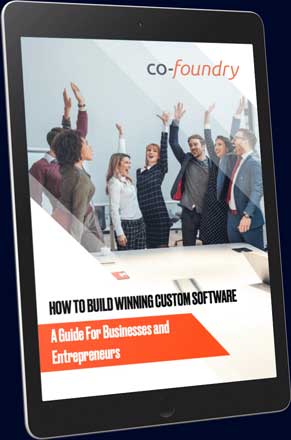How To Scope A Custom Software or App Development Project

How To Scope A Custom Software or App Development Project
You’ve identified a real need in your industry or marketplace that aligns with your existing business. Because of your experience in the industry you know this can work…You’ve got a wonderful idea for some software or an app. But what comes next? Do you start executing your idea immediately? And where exactly should you start? With the design? With the technology? With research?
Thoroughly scoping your idea before you start executing anything at all is the best way to begin. It leaves you with a detailed plan that covers every aspect of your idea. It identifies potential pitfalls early on and uses testing to validate the idea. Without accurate scoping done early, you are almost always going to need more time and budget than you anticipated because of unforeseen items needed in the development roadmap. This is known as “scope-creep”. Another thing you’re going to avoid with scoping is building parts of the project you don’t need. This will save you a lot of time and investment in the long run.
At Co-Foundry we do project scoping for our clients all the time to help bring their visions to life, while saving them time and money in the long run. In this article, we take you through the steps we use when scoping projects and the questions you’ll need to answer along the way.
What Is Development Scoping?
Development scoping creates a clear picture of the objectives of the project and exactly what it will take to achieve them.
Development scoping can cover many areas. These range from understanding the expected outcome of the project and the user journey, to the functionality of the app or software and what its build will look like.
Importantly, it predicts problems that you, and your developers and designers can take into account before starting a build. It also outlines milestones and estimates around timeline and costs so that you know exactly what to expect before you start with the project.
Why It’s So Important to Start Every Development Project With Thorough Project Scoping
Starting a project without scoping it first is like building a house without a plan. You won’t know where to lay the foundations, how much of each material to buy, what it will cost, and how long it will take to build it. On top of that, there’s no guarantee you’ll even like the house once it’s complete or that it will meet your needs. Or perhaps you’ll run out of money before the roof has even gone up. These are some of the risks you face when building a house without a plan.
A Project Scope Is Like An Architect’s Plan for Building A House
A project scope covers all these details and more before the software or app development has even begun. It provides a detailed plan of what the final product will be, how it will work, what you need for the build, and the steps to build it.
By following a certain framework and answering specific questions when you scope a project, you may be forced to think about aspects of the project you hadn’t taken into consideration.
The plan will also help you to build your product using the agile development methodology. This means you’ll build a first version of your product which only contains high priority features. Then you’ll test it, and use the feedback to build an improved version. You also release more and more of the needed features in the following versions, making use of user feedback as you go. This ensures you’re building a product that will actually be adopted and used by your user base. You’ll keep doing this until you have your ideal product.
Market Research, Defining Requirements and General Scoping
When you scope a project, you’ll start by considering the overall picture. How will your product look and who will buy it? Are there similar products in the market? What do you need to do to start making money as quickly as possible?
When we start project scoping for our clients, we sit down with a blank piece of paper and write down all our ideas together.
During this initial phase, we try to find out what the critical success factor is for that project. What is critical to the project’s success? Or, phrased differently, what will without a doubt cause it to fail?
Critical success factors in software and app development projects are often related to security and privacy, good user experience, reliability, marketing, and of course, making sure you’re solving the users’ problem.
Minimum Viable Product – The Key To Faster Returns and A Better Overall Product
Of course, as with any business, you’ll want to start making money off of your product as soon as possible. To do this, you’ll need to work out what your minimum viable product (MVP) will look like. This is a version of your product that only includes the main, sometimes basic, features and still packs in enough value that it’ll easily sell in your market.
Again, scoping early on will ensure the best possible MVP is launched that is a solid base to build the rest of the software onto…
This Helps You Get To Market Faster And Start Selling Early On
Once you have this MVP you can start marketing and selling it. This means you’re going to get ROI sooner rather than later, because you’re not waiting for the entire project, with all features and functions, before going to market.
Understanding Your Market
You’ll also be building a base of loyal customers early on in the development process. And you’ll use your customers’ feedback to develop new, improved versions of the product so the final product is that much more user focused in the end.
Having a clear idea of who your ideal target market is, as well as who your competitors are, is also vital and can be included in the scoping document. Is there a sector of the market that is unserved or underserved that you can target? What are your competitors doing that you can do better or differently?
The most important thing to know and note down in the project scope is what your users’ needs are. If you don’t know what need or needs you’re trying to address with your product, there’s unlikely to be a demand for it. Include market research in the scope to ensure you know what you’re working towards.
Documentation and Tech Team Review
The next step in the scoping exercise is to be as clear as possible about the design of your idea, as well as how its software will work.
Mapping Our User Journeys So Your Software is Usable
Do you know what journey your users will take when using your product? Mapping out exactly what steps a user takes to reach their goal, for example, making a purchase, can help identify areas for improvement.
There is also often more than one type of user for each software product. Keep in mind that a separate user journey will need to be mapped out for each user type.
Are there places in their journey which cause frustration because they take too long to execute or aren’t intuitive enough? Understanding how the user will interact with your product will help you to improve it so they can reach their goal quickly and easily.
Understanding Which Technology Is Best For Your Project
Knowing what technology to incorporate into your build will prevent you from having to change tech at a later stage, potentially costing a lot of money and wasting valuable time.
Consider what technology stack you should be using. Take the size and purpose of your project into account when deciding on which programming languages, frameworks, libraries, and software products to use.
If you don’t understand this already, don’t worry! At Co-Foundry we’re experts and making complicated tech language understandable. We’ll help you choose the perfect technology for your project’s needs.
Imagine your technology stack as the frame or skeleton of a house. It acts as the foundation, beams, and other support structures that the house is built around. Without them, you won’t be able to build a strong, stable house.
Choosing the right tech stack will determine how viable your product is, as well as how it functions, how straightforward it is to maintain, and whether it can easily be scaled up in the future.
Understanding Which Other Technologies Are Involved
Which integrations should be used in your app or software is another aspect to consider. The right ones can add value to your product and help attract or retain customers. Alternatively, not being smart about which apps yours can interface with could result in lost customers. Are there interfaces you should include to make your users’ journey easier? Which other apps should your software interface with? Include these details in your scoping document.
Other questions we ask our clients to answer in the scoping process include what risk, assumptions, issues, and dependencies are involved in the project? This helps us to know what your release plan will look like to achieve maximum success for your software.
Wireframe Mock-ups – Your Project Comes Alive!
Once you know what your product requirements and features look like and what functions will be needed, it’s time to develop a working wireframe prototype. This is the really exciting part of the scoping process as elements of your idea are brought to life.
A wireframe is a very basic build that shows the essential design elements and content. While this prototype won’t have a complete, coded back-end yet, it will contain an outline of your idea’s layout.
Instead of trying to explain your idea to stakeholders, you now have a visual representation of the product. People can click through it and experience a level of interaction similar to what you’d experience on the actual product. If you’re looking for investment, this is something tangible you can use to show potential investors.
But this step isn’t just for stakeholders. It also allows you to see how your idea looks and whether the user journeys you’d envisioned are actually feasible. Does the product look the way you thought it would? Does it work the way you hoped it would? Test the prototype to evaluate its workability and validate the idea.
Testing and making improvements on the prototype before starting the main build will save you time and money.
Roadmap
The last part of your scoping document will be your ‘roadmap’. Now that you know what your idea will look like and how it will work, you need to plan how to make it happen. In this roadmap, you’ll predict timelines for the releases as well as cost estimations.
This should give you a reasonably accurate idea of what it will take to bring your idea to life, and the ideal team size needed to do so.
We’ve got this
If this seems a bit overwhelming and you would prefer a professional team to do this important project scoping step for you, Co-Foundry is here for you. Just like an architect’s drawings for a new home, our scoping process will clearly define your dream for you. You and your stakeholders can use it to more accurately predict the future success and costs of your project.

Want Help With Your Software Project?
Get Our Free Ebook: How to Build Winning Custom Software – A Guide For Businesses and Entrepreneurs
By subscribing, you agree to get emails from Co-Foundry. We’ll respect your privacy and you can unsubscribe at any time.






